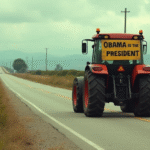Introduction to the AI Challenge
As artificial intelligence (AI) poised to disrupt numerous sectors of the economy, American labor unions are organizing to support employees, pressure companies for transparency, and mobilize politicians.
Aaron Novik, a key figure in the ALU (Amazon Workers Union), explains, “As workers, our only means of pressure is to refuse work. What happens when that disappears due to AI? It’s a genuine existential question.”
Historical Context of Automation
Since the 1960s, automation has transformed most industries, often resulting in workforce reductions. However, the term “Physical AI” is paving the way for a new generation of intelligent robots capable of performing various tasks, potentially replacing many workers.
Potential Job Displacement
According to Anthropic’s CEO, creator of Claude (a competitor to ChatGPT), generative AI in the services sector could lead to the elimination of half of less-skilled jobs, raising unemployment by 10-20%.
Peter Finn, from the Teamsters (trucking) union, states, “Job and employment loss concerns are significant—not just for our members but for everyone.”
Legislative Efforts and Obstacles
Many leaders have focused on combating this advancement through legislation, but they face political hurdles. For instance, California’s governor has twice vetoed a law prohibiting autonomous trucks from operating on public roads, despite pressure from unions with thousands of members in the state.
“Missing the Train”
Under President Joe Biden (2021-2025), the Department of Labor issued recommendations for companies in October 2022, urging transparency on AI usage, involving employees in strategic decisions, and supporting those at-risk positions.
However, shortly after his inauguration in January 2023, Donald Trump revoked the presidential decree that served as a basis for these guidelines.
Union Strategies and Successes
HeeWon Brindle-Khym from RWDSU (representing wholesale and retail workers) says, “The message is clear: they want to open everything up to AI without the necessary safeguards to protect workers’ rights and ensure their well-being.”
Dan Reynolds from CWA (Communications Workers of America) notes, “Companies are rushing out of fear of missing the AI train. Many implementations have been poorly executed, and if consulted, our members could have warned us about these tools’ ineffectiveness.”
Union Initiatives and Successes
The CWA published an online report in November 2023 with advice for members, including integrating AI into collective bargaining. Currently, the union is developing educational packages for its members.
Some unions have successfully included AI protections in contracts with companies, such as media group Ziff Davis (owner of Mashable) and video game publisher ZeniMax Studios, a Microsoft subsidiary.
Key Successes and Challenges
The most notable successes in this battle come from two powerful unions: port workers (ILA) with a moratorium on total automation of certain operations and Hollywood actors (SAG-AFTRA) ensuring consultation and compensation for AI-generated doubles.
However, these examples are exceptions. In most cases, the US labor movement lacks sectoral bargaining power, requiring individual company negotiations—a “long and slow” process.
Virginia Doellgast, a Cornell University professor specializing in labor relations, believes workers generally don’t aim to halt technological progress. “They simply want some control,” she asserts.
Key Questions and Answers
- Q: How are unions responding to the AI threat?
A: Unions are organizing to support employees, pressure companies for transparency, and mobilize politicians.
- Q: What is the potential impact of Physical AI on jobs?
A: Physical AI could lead to the creation of advanced robots capable of performing various tasks, potentially replacing many workers.
- Q: What legislative efforts are unions pursuing?
A: Unions are advocating for transparency in AI usage, employee involvement in strategic decisions, and support for workers at-risk positions.
- Q: What challenges do unions face in addressing AI?
A: Unions encounter political obstacles and must navigate individual company negotiations, a lengthy process.
- Q: What successes have unions achieved in dealing with AI?
A: Some unions have secured AI protections in contracts, ensuring consultation and compensation for AI-generated content.






